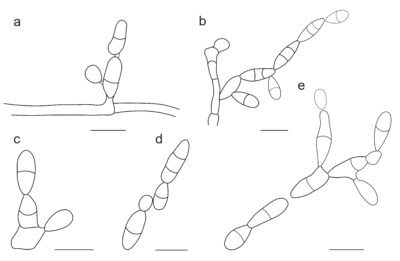Fungalpedia – Note 397, Meristemomyces
Meristemomyces Isola & Onofri
Citation when using this data: Tibpromma et al. (in prep.) – Fungalpedia, Rock-inhabiting fungi.
Index Fungorum, Facesoffungi, MycoBank, GenBank, Fig. 1
Classification: Incertae sedis, Capnodiales, Dothideomycetidae, Dothideomycetes, Pezizomycotina, Ascomycota, Fungi.
Meristemomyces was introduced by Egidi et al. (2014), and Meristemomyces frigidus was designated as the type species. Phylogenetic analysis of LSU, rpb2, ITS, and BT2 sequences using Bayesian methods Meristemomyces was classified within Teratosphaeriaceae. Later, Crous et al. (2016) added a second species to the genus Meristemomyces arctostaphyli, which was isolated from the leaves of Arctostaphylos patula (Ericaceae) in Utah, USA, near the Long Valley. Meristemomyces frigidus is a rock-inhabiting fungus isolated from rocks in the Himalayas (Egidi et al. 2014). The placement of Meristemomyces within Teratosphaeriaceae was confirmed by Crous et al. (2016) based on further phylogenetic analysis. Originally, the generic name Meristemomyces was deemed invalid under Article 40.7 (Shenzhen) of the nomenclatural rules due to procedural issues in its introduction by Egidi et al. (2014). This was subsequently addressed by Crous et al. (2019), who published Meristemomyces as a validly established name, thus rectifying the initial oversight.
Type species: Meristemomyces frigidus D. Isola & S. Onofri
Other accepted species: Species Fungorum – search Meristemomyces
Figure 1 –Meristemomyces arctostaphylos. a–e Conidiophores and chains of conidia. Scale bars: a–e = 10 μm. Redrawn from Crous et al. (2016).
References
Entry by
Wanasinghe DN, Center for Mountain Futures, Kunming Institute of Botany, Chinese Academy of Sciences, Honghe 654400, China.
(Edited by Saowaluck Tibpromma, Samaneh Chaharmiri-Dokhaharani, & Achala R. Rathnayaka)
Published online 26 November 2024
